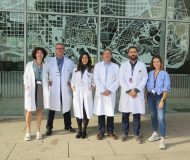

Motor cortical stimulation could be a promising therapeutic alternative for patients with chronic neuropathic pain who do not respond to conventional treatments, according to the results of a multicenter study conducted by researchers from the Neurosurgery Group at the Research Institute of the Hospital de la Santa Creu i Sant Pau – IIB Sant Pau, in collaboration with the Hospital del Mar Research Institute, published in the journal Neurosurgery.
The study, led by Dr. Rodrigo Rodríguez Rodríguez, a researcher and neurosurgeon at Sant Pau, analyzes data from one of the world’s largest cohorts of patients with treatment-resistant neuropathic pain who underwent motor cortical stimulation as a rescue therapy. This technique involves the implantation of electrodes on the surface of the brain in specific areas indirectly related to pain circuits.
The results demonstrate the long-term effectiveness of motor cortical stimulation in the treatment of neuropathic pain, specifically trigeminal neuralgia. Of the evaluated patients, 42% showed a positive response to motor cortical stimulation after 6 months. Additionally, there was an average reduction of 34% in pain intensity.
Dr. Juan Aibar, from the Neurosurgery Group at IIB Sant Pau and a neurosurgeon at the same hospital, explains that neuropathic pain is a form of pain that persists even though the injury that caused it no longer exists. It is related to central or peripheral nervous system lesions and is especially difficult to control with conventional treatments. Patients suffering from this condition often experience associated problems such as anxiety, depression, and work-related issues, in addition to a significant impact on their quality of life.
“It is crucial that motor cortical stimulation is carried out in specialized centers with well-established headache and neuralgia units,” emphasizes this expert, adding that this is due to “the complexity of patients seeking this treatment and the need for a thorough evaluation before considering it as a suitable alternative.”
Dr. Aibar also highlights the importance of considering the pain’s semiology, meaning understanding the nuances of neuropathic pain and its underlying cause, as each case may have different outcomes with neuromodulation therapy. “For example, if it is multiple sclerosis, herpes, trauma, or trigeminal neuralgia at onset… all these conditions can cause this type of facial pain, and each one has a different outcome with neuromodulation therapy,” Dr. Aibar comments.
This is a highly specific cerebral neuromodulation treatment for patients with severe neuropathic pain, performed at very few centers in Spain. This is the reason that led the authors of these two Catalan centers, which have more experience in this neuromodulation technique in Catalonia, to gather and jointly analyze the data. “In cerebral neuromodulation, studies should be multicenter because it is the only way to obtain sufficient data to reach conclusions,” explains Dr. Gloria Villalba, coordinating neurosurgeon of the Neurosurgery Service at the Hospital del Mar and co-principal author of the publication, along with Dr. Juan Aibar and Dr. Rodrigo Rodríguez.
These findings highlight the importance of continuing to research motor cortical stimulation as a valuable option for the treatment of chronic neuropathic pain, especially trigeminal neuralgia. This study represents a significant step toward a more comprehensive and effective understanding of the treatment of treatment-resistant neurological conditions.
Aibar-Durán, Juan Ángel MD; Villalba Martínez, Gloria MD; Freixer-Palau, Berta; Araus-Galdós, Elena; Morollón Sanchez-Mateos, Noemi; Belvis Nieto, Robert; Revuelta Rizo, Miren MD; Molet Teixeido, Joan; García Sánchez, Carmen; de Quintana Schmidt, Cristian; Muñoz Hernandez, Fernando; Rodríguez Rodríguez, Rodrigo. Long-Term Results of Cortical Motor Stimulation for Neuropathic Peripheral and Central Pain: Real-World Evidence From Two Independent Centers. Neurosurgery. August 28, 2023. | DOI: 1227/neu.0000000000002638